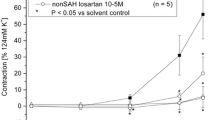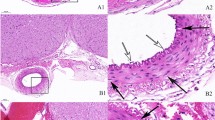Summary
Disturbance of the autoregulation of the cerebral blood flow (CBF) is frequently seen following subarachnoid haemorrhage (SAH) and is possibly partly caused by cerebral ischaemia. It is well-known, that the calcium channel blocker nimodipine reduces the incidence of cerebral infarction and ischaemic dysfunction after SAH.
The aim of the present study was to investigate the effect of nimodipine on autoregulation of CBF in an experimental model of SAH. The autoregulation was investigated in 10 control rats with SAH and in 10 nimodipine treated rats with SAH by serial measurements of CBF using a133Xenon intracarotid injection method during controlled blood pressure manipulations.
In the control rats the autoregulation was severely disturbed, no plateau was found where CBF was independent of changes in the arterial blood pressure (MABP). In rats treated with intravenous nimodipine (0.03 mg/kg bodyweight/h), CBF was 33.0% higher and MABP 5.3% higher compared with the controls. CBF was found constant in the MABP interval between 60 and 100 mmHg which indicates, that nimodipine improves the autoregulation of CBF after SAH.
Similar content being viewed by others
References
Allen GS, Ahn HS, Preziosi TJ,et al (1983) Cerebral arterial spasm — a controlled trial of nimodipine in patients with subarachnoid hemorrhage. N Engl J Med 308: 619–624
Auer LM, Brandt L, Ebeling U,et al (1986) Nimodipine and early aneurysm operation in good condition SAH patients. Acta Neurochir (Wien) 82: 7–13
McCalden TA, Nath RG (1989) Cerebrovascular autoregulation is resistant to calcium channel blockade with nimodipine. Experimentia 45: 305–306
Espinosa F, Weir B, Overton T,et al (1984) A randomized placebo-controlled double-blind trial of nimodipine after SAH in monkeys. Part 1: Clinical and radiological findings. J Neurosurg 60: 1167–1175
Forsman M, Fleischer JE, Milde JH,et al (1986) The effects of nimodipine on cerebral blood flow and metabolism. J Cereb Blood Flow Metab 6: 763–767
Gaab MR, Haubitz I, Brawanski A,et al (1985) Acute effects of nimodipine on the cerebral blood flow and intracranial pressure. Neurochirurgia 28: 93–99
Germano IM, Bartkowski HM, Cassel ME,et al (1987) The therapeutic value of nimodipine in experimental focal cerebral ischemia. Neurological outcome and histopathological findings. J Neurosurg 67: 81–87
Grotenhuis JA, Bettag W, Fiebach BJO,et al (1984) Intracarotid slow bolus injection of nimodipine during angiography for treatment of cerebral vasospasm after SAH. J Neurosurg 61: 231–240
Harper AM, Craigen L, Kazda S (1981) Effect of the calcium antagonist, nimodipine, on cerebral blood flow and metabolism in the primate. J Cereb Blood Flow Metab 1: 349–356
Hauerberg J, Juhler M, Rasmussen G (1993) Cerebral blood flow autoregulation after experimental subarachnoid hemorrhage during hyperventilation in rat. J Neurosurg Anesth 5: 258–263
Haws CW, Gourley JK, Heistad DD (1983) Effects of nimodipine on cerebral blood flow. J Pharm Exp Therap 225: 24–28
Hernandez MJ, Brennan RW, Bowman BS (1978) Cerebral blood flow autoregulation in rat. Stroke 9: 150–155
Hertz MM, Hemmingsen R, Bolwig TG (1977) Rapid and repetitive measurements of blood flow and oxygen consumption in the rat brain using intraarterial xenon injection. Acta Physiol Scand 101: 501–503
Höllerhage H-G, Gaab MR, Zumkeller M,et al (1988) The influence of nimodipine on cerebral blood flow autoregulation and blood-brain barrier. J Neurosurg 69: 919–922
van den Kerckhoff W, Kazda S (1987) The autoregulation of cerebral blood flow is influenced by calcium antagonists. J Cereb Blood Flow Metab 7 [Suppl 1]: 169
Lassen NA: Brain extracellular pH (1968) The main factor controlling cerebral blood flow. Scand J Lab Clin Invest 2: 247–251
Ljunggren B, Brandt L, Säveland H,et al (1984) Outcome in 60 consecutive patients treated with early aneurysm operation and intravenous nimodipine. J Neurosurg 61: 864–873
Mee E, Dorrance D, Lowe D,et al (1988) Controlled study of nimodipine in aneurysm patients treated early after subarachnoid hemorrhage. Neurosurgery 22: 484–491
Mendelow AD (1988) Pathophysiology of delayed ischemic dysfunction after subarachnoid hemorrhage: experimental and clinical data. Acta Neurochir (Wien) [Suppl] 45: 7–10
Messeter K, Brandt L, Ljunggren B,et al (1987) Predictation and prevention of delayed ischemic dysfunction after aneurysmal subarachnoid hemorrhage and early operation. Neurosurgery 20: 548–553
Mohamed AA, Mendelow AD, Teasdale GM,et al (1985) Effect of the calcium antagonist nimodipine on local cerebral blood flow and metabolic coupling. J Cereb Blood Flow Metab 5: 26–33
Mokry M, Ishiyama N, Kleinert R,et al (1987) Nimodipine opens collaterals during acute focal ischemia. J Cereb Blood Flow Metab 7 [Suppl 1]: 164
Öhman J, Heiskanen O (1988) Effect of nimodipine on the outcome of patients after aneurysmal subarachnoid hemorrhage and surgery. J Neurosurg 69: 683–686
Öhman J, Servo A, Heiskanen O (1991) Long-term effects of nimodipine on cerebral infarcts and outcome after aneurysmal subarachnoid hemorrhage and surgery. J Neurosurg 74: 8–13
Olesen J, Paulson OB, Lassen NA (1971) Regional cerebral blood flow in man determinated by the initial slope of the clearance of intra-arterially injected133xenon. Stroke 2: 519–540
Paulson OB, Olesen J, Christensen MS (1972) Restoration of autoregulation of cerebral blood flow by hypocapnia. Neurology 22: 286–293
Petruk KC, West M, Mohr G,et al (1988) Nimodipine treatment in poor-grade aneurysm patients. J Neurosurg 68: 505–517
Pickard JD, Murray GD, Illingworth R,et al (1989) Effect of oral nimodipine on cerebral infarction and outcome after subarachnoid haemorrhage: British aneurysm nimodipine trail. BMJ 298: 636–642
Pozzilli C, DiPiero V, Pantano P,et al (1989) Influence of nimodipine on cerebral blood flow in human cerebral ischaemia. J Neurol 236: 199–202
Rasmussen G, Hauerberg J, Waldemar G,et al (1992) Cerebral blood flow autoregulation in experimental subarachnoid haemorrhage in rat. Acta Neurochir (Wien) 119: 128–133
Sahlin C, Brismar J, Delgado T,et al (1987) Cerebrovascular and metabolic changes during delayed vasospasm following experimental subarachnoid hemorrhage in baboons, and treatment with a calcium antagonist. Brain Res 403: 313–332
Schmidt JF, Waldemar G (1990) Effect of nimodipine on cerebral blood flow in human volunteers. J Cardiovasc Pharmacol 16: 568–571
Schmidt JF, Waldemar G, Paulson OB (1991) The acute effect of nimodipine on cerebral blood flow, its CO2 reactivity, and cerebral oxygen metabolism in human volunteers. Acta Neurochir (Wien) 111: 49–53
Strandgaard S, Paulson OB (1984) Cerebral autoregulation. Stroke 15: 413–416
Svendgaard NAa, Brismar J, Delgado T,et al (1983) Late cerebral arterial spasm: The cerebrovascular response to hypercapnia, induced hypertension and the effect of nimodipine on blood flow autoregulation in experimental subarachnoid hemorrhage in primates. Gen Pharmac 14: 167–172
Takeuchi H, Handa Y, Kobayashi H,et al (1991) Impairment of cerebral autoregulation during the development of chronic cerebral vasospasm after subarachnoid hemorrhage in primates. Neurosurgery 28: 41–48
Tally PW, Sundt TM, Anderson RE (1989) Improvement of cortical perfusion, intracellular pH, and electrocorticography by nimodipine during transient focal cerebral ischemia. Neurosurgery 24: 80–87
Voldby B (1988) Pathophysiology of subarachnoid haemorrhage. Experimental and clinical data. Acta Neurochir (Wien) [Suppl] 45: 1–6
Voldby B, Enevoldsen E, Jensen FT (1985) Cerebrovascular reactivity in patients with ruptured intracranial aneurysms. J Neurosurg 62: 59–67
Young WL, Chien S (1989) Effect of nimodipine on cerebral blood flow and metabolism in rats during hyperventilation. Stroke 20: 275–280
Author information
Authors and Affiliations
Rights and permissions
About this article
Cite this article
Hauerberg, J., Rasmussen, G., Juhler, M. et al. The effect of nimodipine on autoregulation of cerebral blood flow after subarachnoid haemorrhage in rat. Acta neurochir 132, 98–103 (1995). https://doi.org/10.1007/BF01404855
Issue Date:
DOI: https://doi.org/10.1007/BF01404855




